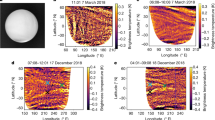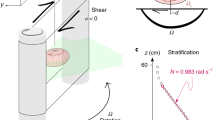Abstract
Polar vortices are common in the atmospheres of rapidly rotating planets1,2,3,4. On Earth and Mars, vortices are generated by surface temperature gradients and their strength is modulated by the seasonal insolation cycle1,2,3. Slowly rotating Venus lacks pronounced seasonal forcing, but vortices are known to occur at both poles, in an atmosphere that rotates faster than the planet itself5,6,7,8. Here we report observations of cloud motions at altitudes of 42 and 63 km above Venus’s south pole using infrared images from the VIRTIS instrument onboard the Venus Express spacecraft. We find that the south polar vortex is a long-lived but unpredictable feature. Within the two cloud layers sampled, the centres of rotation of the vortex are rarely aligned vertically and both wander erratically around the pole with velocities of up to 16 m s−1. At the two horizontal levels, the observed cloud morphologies do not correlate with the vorticity of the wind field and change continuously, and vertical and meridional wind shears are also highly variable. We conclude that Venus’s south polar vortex is a continuously evolving structure that is at least 20 km high, extending through a quasi-convective turbulent region.
This is a preview of subscription content, access via your institution
Access options
Subscribe to this journal
Receive 12 print issues and online access
$259.00 per year
only $21.58 per issue
Buy this article
- Purchase on Springer Link
- Instant access to full article PDF
Prices may be subject to local taxes which are calculated during checkout




Similar content being viewed by others
References
Hamilton, K. Dynamical coupling of the lower and middle atmosphere: Historical background to current research. J. Atmos. Sol-Terr. Phys. 61, 73–84 (1999).
Waugh, D. W. & Polvani, L. M. Stratospheric polar vortices. Geophys. Monog. Ser. 190, 43–58 (2010).
Giuranna, M. et al. PFS/MEX observations of the condensing CO2 south polar cap of Mars. Icarus 197, 386–402 (2008).
Dyudina, U. A. et al. Saturn’s south polar vortex compared to other large vortices in the Solar System. Icarus 202, 240–248 (2009).
Suomi, V. E. & Limaye, S. S. Venus: Further evidence of vortex circulation. Science 201, 1009–1011 (1978).
Taylor, F. W. et al. Structure and meteorology of the middle atmosphere of Venus: Infrared remote sensing from the Pioneer Orbiter. J. Geophys. Res. 85, 7963–8006 (1980).
Schofield, J. T. & Diner, D. J. Rotation of Venus’s polar dipole. Nature 305, 116–119 (1983).
Piccioni, G. et al. South-polar features on Venus similar to those near the north pole. Nature 450, 637–40 (2007).
Drossart, P. et al. Scientific goals for the observation of Venus by VIRTIS on ESA/Venus express mission. Planet. Space Sci. 55, 1653–1672 (2007).
Barstow, J. K. et al. Models of the global cloud structure on Venus derived from Venus Express observations. Icarus 217, 542–560 (2012).
Ignatiev, N. I. et al. Altimetry of the Venus cloud tops from the Venus Express observations. J. Geophys. Res. 114, E00B43 (2009).
Peralta, J. et al. Solar migrating atmospheric tides in the winds of the Polar Region of Venus. Icarus 220, 958–970 (2012).
Titov, D. V. et al. Morphology of the cloud tops as observed by the Venus Express Monitoring Camera. Icarus 217, 682–701 (2012).
Luz, D. et al. Venus’s southern polar vortex reveals precessing circulation. Science 332, 577–580 (2011).
Sánchez-Lavega, A. et al. Variable winds on Venus mapped in three dimensions. Geophys. Res. Lett. 35, L13204 (2008).
Hueso, R., Peralta, J. & Sánchez-Lavega, A. Assessing the long-term variability of Venus winds at cloud level from VIRTIS–Venus Express. Icarus 217, 585–598 (2012).
Gierasch, P. J. et al. in VENUS II: Geology, Geophysics, Atmosphere, and Solar Wind Environment (eds Bougher, S. W., Hunten, D. M. & Philips, R. J.) 459–500 (Arizona Univ. Press, 1997).
Gierasch, P. J. Meridional circulation and the maintenance of the Venus atmospheric rotation. J. Atmos. Sci. 32, 1038–1044 (1975).
Rossow, W. B. & Williams, G. P. Large-scale motion in the Venus stratosphere. J. Atmos. Sci. 36, 377–389 (1979).
Tsang, C. C. C. et al. Tropospheric carbon monoxide concentrations and variability on Venus from Venus Express/VIRTIS-M observations. J. Geophys. Res. 113, E00B08 (2008).
Limaye, S. S. et al. Vortex circulation on Venus: Dynamical similarities with terrestrial hurricanes. Geophys. Res. Lett. 36, L04204 (2009).
Lee, C., Lewis, S. R. & Read, P. L. A bulk cloud parameterization in a Venus General Circulation Model. Icarus 206, 662–668 (2010).
Montabone, L. et al. Barotropic instability of planetary polar vortices: Concept, experimental set-up and parameter space analysis. Proc. HYDRALAB III Joint User Meeting 191–194 (2010).
Tellmann, S., Pätzold, M., Häusler, B., Bird, M. K. & Tyler, G. L. Structure of the Venus neutral atmosphere as observed by the radio science experiment VeRa on Venus Express. J. Geophys. Res. 114, E00B36 (2009).
Lee, Y. J. et al. Vertical structure of the Venus cloud top from the VeRa and VIRTIS observations onboard Venus Express. Icarus 217, 599–609 (2012).
Piccialli, A. et al. Dynamical properties of the Venus mesosphere from the radio-occultation experiment VeRa onboard Venus Express. Icarus 217, 669–681 (2012).
Hueso, R., Legarreta, J., Garcı´a-Melendo, E., Sánchez-Lavega, A. & Pérez-Hoyos, S. The jovian anticyclone BA II. Circulation and interaction with the zonal jets. Icarus 203, 499–515 (2009).
Acknowledgements
We wish to thank Y. J. Lee and S. Tellmann for providing VeRa data. We gratefully acknowledge the work of the entire Venus Express team that allowed these data to be obtained. We wish to thank ESA for supporting the Venus Express mission, ASI (by the contract I/050/10/0), CNES and the other national space agencies supporting the VIRTIS instrument onboard. J.P. acknowledges support from the Portuguese Foundation for Science and Technology (FCT, grant reference: SFRH/BPD/63036/2009). This work was supported by the Spanish MICIIN project AYA2009-10701 and AYA2012-36666 with FEDER support, Grupos Gobierno Vasco IT-464-07 and UPV/EHU UFI11/55.
Author information
Authors and Affiliations
Contributions
I.G-L. performed the image selection and wind measurements. R.H. designed the measurement software. A.S-L. coordinated this research and with J.P. made theoretical interpretations. P.D. and G.P. have coordinated the observations as Principal Investigators of VIRTIS. All the authors discussed the results and commented on the manuscript.
Corresponding author
Ethics declarations
Competing interests
The authors declare no competing financial interests.
Supplementary information
Supplementary Information
Supplementary Information (PDF 1114 kb)
Supplementary Information
Supplementary Information (GIF 513 kb)
Rights and permissions
About this article
Cite this article
Garate-Lopez, I., Hueso, R., Sánchez-Lavega, A. et al. A chaotic long-lived vortex at the southern pole of Venus. Nature Geosci 6, 254–257 (2013). https://doi.org/10.1038/ngeo1764
Received:
Accepted:
Published:
Issue Date:
DOI: https://doi.org/10.1038/ngeo1764
This article is cited by
-
Thermal structure of the Venusian atmosphere from the sub-cloud region to the mesosphere as observed by radio occultation
Scientific Reports (2020)
-
Planetary-scale streak structure reproduced in high-resolution simulations of the Venus atmosphere with a low-stability layer
Nature Communications (2019)
-
Venus looks different from day to night across wavelengths: morphology from Akatsuki multispectral images
Earth, Planets and Space (2018)
-
Stationary waves and slowly moving features in the night upper clouds of Venus
Nature Astronomy (2017)
-
Venus Surface Composition Constrained by Observation and Experiment
Space Science Reviews (2017)



